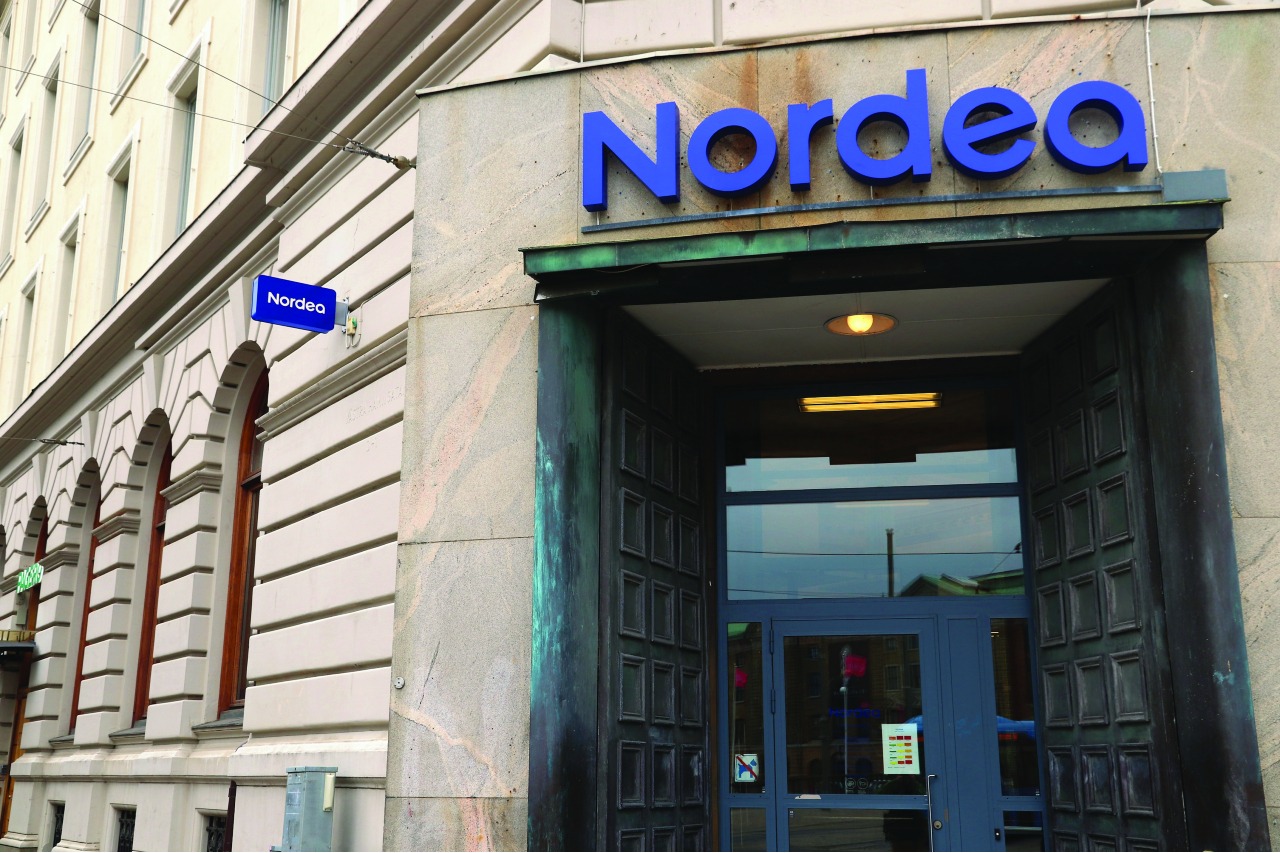
From digital self-service solutions to shifting offerings online, Nordea is clearly an institution on the move. But after a chaotic 18 months, do established financial institutions really have the money to jump into a fully digital world? And beyond the cliches, what will that world actually look like?
Isabel Ellis talks to Tino Kam, Nordea’s head of product management, transaction banking, to learn about the Finnish bank’s new customer-facing digital services, how data analytics is the key to the company’s monetisation efforts – and how working with fintechs might be the key to pushing change forward, even in an uncertain economic environment.
Some pandemics are a punishment for what’s gone before. Through a certain lens, this one might have shown that people knew what they were doing. Where once there was divine judgement, now there is acceleration.
Nordea didn’t embrace digital transformation in the mid-2010s with this specific scenario in mind, but chief portfolio officer Jukka Salonen can look back on his speech at MoneyLIVE Digital Banking 2019 with more than the usual pride.
“We realise that you don’t always know what is going to happen in the coming years,” he told a London crowd, blissfully unaware that it would not be returning in 12 months.
“And, so, one of our cornerstones has been to build up capabilities to be adaptive to different kinds of futures, so we have flexibility in what we do.”
Flexibility is one way to put it. The striking thing about what Tino Kam, Nordea’s head of product management, transaction banking, has to say of his employer’s plague year is how little it offers in the way of twists and surprises.
Of course, that comes with caveats. No one is emerging from Covid-19 the same way they went in – certainly not after a 66% fall in operating profits between Q1 and Q2 2020. “It was definitely an interesting period for the industry,” Kam says – with a pause before ‘interesting’ long enough to raise the suspicion it might be caused by connectivity issues.
As it turns out, he’s just thinking. The pandemic has led to a lot of that. For better and worse, one thing that has become clear to anyone who took a moment to reflect is how few of life’s practicalities now require social or physical contact. “If I just look at myself as a consumer,” notes Kam, by way of example, “I don’t need cash and I don’t need to go to shops.”
Nordea’s move away from its legacy infrastructure to a centralised, digital-first one put it in the ideal position to serve its customers when avoiding shops became vital. It simply had to emphasise the elements of its offering that already catered to digital life across Scandinavia.
In fact, once the bank was able to ensure that its staff were safe, comfortable and supported working from home, it was able to optimise pre-existing processes rather than building new ones under pressure.
Tellingly, the pandemic has spanned the end of the ‘Execution’ phase and the beginning of the ‘Optimisation’ stage of the digital, mobile-first transformation Nordea announced in 2015. The €600m fall in profits from Q2 2019 and 2020 became a €1bn gain over the following year.
Smooth operations
“We were already well on our way to becoming very digital and self-service, and – obviously apart from the physical branches – we were able to support our customers through business as usual,” Kam explains. Even in corporate transaction banking, it was more a process of extending and porting capabilities than anything else.
“E-commerce was already experiencing almost double-digit growth every year, but because of Covid, that has obviously accelerated – in B2B as well as B2C,” continues Kam.
“We were already supporting our corporates from an e-commerce perspective – providing PSP [payment service provider] capabilities, providing smooth checkout capabilities for their online sales – but I think more and more corporates have put their ecom strategy higher up their agenda. Not only from a consumer, but from a corporate perspective, we are trying to push that needle even further towards being digital and self-service.”
By mid-2021, Nordea’s omnichannel netbank had been rolled out to more than 50% of its corporate customers. None of this is ground-breaking. At base, transaction banking is about ensuring corporate customers’ daily banking needs and services run as smoothly and as cost-effectively as possible.
It’s as much about ease and convenience as its consumer equivalent, making digitalisation equally appropriate. Beyond that, a good banking partner helps CFOs, corporate treasurers and finance departments understand and mitigate risk, and – “very importantly”, Kam stresses – does all it can to add value to their companies.
That also comes down to convenience. The less time a finance department has to spend phoning its bank, filling out forms and troubleshooting, the more it can drive the business forward.
“So,” Kam summarises, “the core pressure is to become a more strategic player for the CFO and the company. We need to ensure that daily banking services are running smoothly and efficiently, so, where we can, we digitalise, we automate, we become more self-service… to free up time, capacity and resources for corporate treasuries to become more strategic for their businesses.”
The data case
Tellingly, the banks that performed best through the pandemic had long since strategised for digitalisation, exploiting their vast information reserves to understand and adapt to how consumer preferences and technological developments were changing society.
In many respects, the necessities of competing with tech-driven challengers and complying with stringent regulatory regimes have made the banking industry one of the most advanced and data-literate in Europe. This is good news for corporate customers – particularly post-Covid-19.
“The trend was happening before Covid, but over the last 18 months, there has been an acceleration in all areas around helping our customers to better manage their risk,” explains Kam.
That means ensuring that corporate clients have access to dashboards and cockpits that efficiently consolidate all the pertinent data points for determining their risk positions, and that they have the relevant information to make their forecasts even more accurate.
“We’re adding data insight services like liquidity management forecasting and we’re working with fintechs with expertise in artificial intelligence to do document checking in trade finance processes,” Kam continues. “It’s all about continuously understanding your customers. We’re using data for our customers – and we have a lot of data.”
All that data gives incumbents certain advantages over smaller competitors, but it’s also tied in with their extra responsibilities. Nordea’s status as the largest bank in Scandinavia is inextricable from its 200-year history as a physical and social component of countless communities.
It’s harder to explain or quantify the value that brings than it is to squander it. Incumbents have relationships with places, people and organisations that challenger banks can’t replicate. Where the latter group can take risks, the former holds trust.
Kam uses this as the basis for a productive and value-driving attitude to regulation, which can be easy to treat as a drain that stops incumbents keeping up with fintech. He points to the P27 initiative for creating an instant cross-border payment infrastructure for the Nordics.
In one respect, it’s a way to implement the latest ISO standards, giving banks better data to work with and improving their payment transparency, transaction monitoring and AML checking capabilities.
“But then there’s also an opportunity to use the infrastructure to further improve our ability to reduce fraud or money laundering by looking at it across borders, where most of those incidents might happen,” Kam explains.
“That’s obviously going beyond pure regulation, but it’s also working with the regulators to see if we can use the infrastructure to support better AML tools.”
Then, of course, there are the advantages of simplifying cross-border payments for Kam’s corporate customers, who often operate across the entire region. Incumbents can either stick to a compliance mindset or use regulation to balance customer demands for convenience and trust.
“There’s always a customer lens to regulatory developments and requirements,” continues Kam. “That’s what we try to do at Nordea – make sure that we understand why we do this. It’s not just about satisfying the regulators, it’s that we continue to be seen as a trusted party, because that is one of the differences between a very regulated bank and a small fintech. Trust is a value for our customers, so we try to ensure that we continue to have their trust.”
Opportunity cost
In this way, framing data monetisation as an opportunity in the same way that fintech does could be disastrous for an incumbent like Nordea. Data isn’t just a window on risk, but a factor contributing to it.
“Of course, there are areas where we are piloting and trying to understand what we can do with data monetisation, but we are a bit conservative and careful there,” says Kam. “In a good way, I think – you don’t want to lose the trust.”
That’s something Nordea prides itself on explaining to fintechs. Particularly given how much of their resources are tied up in complying with regulation, incumbents rarely have the time, spare funds or expertise to build the best AI apps for customers, let alone bust their own silos and remake their infrastructures.
Engaging smaller, more specialised fintechs is often the only option – and it’s here that Nordea’s story has the most relevance to the rest of the industry.
“In anything we do, we need to understand if we can partner before we buy or before we build,” explains Kam.
“Maybe we can find the fintechs who can provide value-added services immediately, who have a given capability that would be great to integrate in our offering, but the journey starts there. Just scanning the market, you can find good solutions, but the challenge is trying to see if you are culturally suited to work together, if they are financially sound and if they can adjust to the complex way banks work.”
Indeed, for all that digitalisation does to spare humans the quirks and annoyances of dealing with each other, it won’t change the fact that banking is a cultural phenomenon.
As their high street histories imply, the complexities of incumbent banks differ depending on where they are. Nordea is careful not to stake its reputation and relationships on a too-hasty digital transformation, but its geography has enabled it to move much faster than many similarly sized institutions.
In contrast with much of Europe, Nordic governments and their citizens have wholeheartedly embraced digital identity services. Bank IDs, for instance, are used for tax submissions as well as online payment authorisations. In Denmark, where Kam lives, the public received their Covid-19 vaccine invites in the same ‘e-Boks’ as their bank statements.
“That’s a big, big benefit in the Nordics,” stresses Kam. “We have the infrastructure already.”
As part of its payment strategy, the EU Commission is trying to extend similar standards across the rest of Europe, but aligning 27 heterogeneous states across a whole continent is a challenge of a different order. Trust isn’t viral.
This article originally appeared in Future Banking winter 2021.






